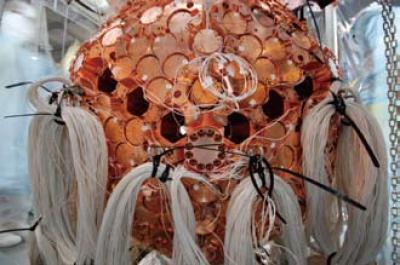
32% of the energy content of the Universe is matter, stuff that both feels and exerts the gravitational force. But the matter that we understand, the matter that we and all planets, stars, and galaxies in this Universe are made of, amounts to only about 16% of all of the matter that gravitates in the universe. The other 84% of all that gravitating matter in the Universe is what we call Dark Matter. We can see its various effects (see other Research Programs), but not itself.
Dark Matter is absolutely needed to explain the composition, distribution, and movement of 16% of all matter that we study in our accelerators and telescopes; let us call it normal matter. That our well developed and highly accurate theory of normal matter simply looks to complex to be complete is a thorn in our side, and Dark Matter is the only indication so far that there is more to matter than the particle physics we know. Direct detection Dark Matter experiments are our attempt to explore Dark Matter with particle physics methods: To find a deeper connection between matter and Dark Matter than the obvious graviational one. Direct detection Dark Matter experiments look for a direct interaction of an individual Dark Matter particle with the normal matter particles that our experimental apparatus is made of. Given the normal matter we have and know this is a HUGE challenge. Normal matter materials contain radioactive isotopes, and those isotopes produce signals that can easily be mistaken for a Dark Matter particle interaction. To purify all materials as much as possible and quantify the remaining isotopes as precisely as possible is one of the most important steps toward pushing this boundary of our knowledge. And this has to be done for ever increasing amounts of material as the size and with it the reach of these detectors grows. The direct detection Dark Matter program at Kavli IPMU reflects these challenges as it extends its science reach with every new generation of detectors.
The first generation XMASS detector is the 834 kg active volume single phase liquid xenon scintillation detector. After commissioning it got refurbished in 2013. The experiment completed accumulating more than 1,600 days of high quality data with the refurbished detector in February of 2019. XMASS produced many papers and also specifically addressed the DAMA/LIBRA annual modulation claim, which is not supported by XMASS data. At XMASS we are also pioneering the use of Machine Learning in the analysis of its data. Since December 2017 a group of XMASS collaborators from Japan has joined the XENON collaboration to prepare for the upgrade of the XENON1T detector to the 2nd generation XENONnT detector. The XENON collaboration is the pioneer in the development of two phase liquid xenon detectors. With XENONnT we expect to be leading the dash to a Weekly Interacting Massive Particle (WIMP) sensitivity on the cross section of 10-48 cm2 for a WIMP mass of 50 GeV/c2. XENONnT started commissioning in the summer of 2019.
(Last update: 2019/10/28)
Links
Members
- Shin'ichiro Ando
- Patrick De Perio
- Nivedita Ghosh
- Elisa Gouvea Mauricio Ferreira
- Johannes Herms
- Katsuki Hiraide
- Shunsaku Horiuchi
- Yasuhiro Kishimoto
- Ryuichiro Kitano
- Chervin Laporte
- Kai Martens
- Thomas (Tom) Melia
- Yuta Michimura
- Shigetaka Moriyama
- Hitoshi Murayama
- Masayuki Nakahata
- Ippei Obata
- Sebastien Peirani
- Hiroyuki Sekiya
- Yevgeny Stadnik
- Yasuhiro Takemoto
- Volodymyr Takhistov
- Masaki Yamashita
- Tianyu Zhu






